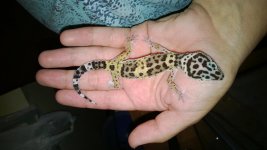^again, I agree. this is all good. soaking will help to rehydrate your gecko as well, and if she feels better hopefully her appetite will come back!
I have re-hab'd geckos who needed assist feeds. I am glad she opens her mouth easily for you

how does her mouth look inside? healthy pink, no signs of irritation or injury? when a gecko is not in the greatest of shape they're more inclined to pick up opportunistic stuff. I hope she doesn't have any mouthrot, as it will make your life easier if she's not fighting a sore mouth too.
hmmm...as for amount. IME, especially if it's been awhile, they'll often regurge what you try to feed. so however much you give her, I would start very slowly. like, a few drops..wait several hours...a few drops again. there's no rush to stuff her full, especially if there's any risk at all of impaction.
have you found a recent poop from her, since separating? if you see a poop she's probably not impacted or not severely impacted (if it's really dry or has a bunch of sand in it its a different story, but either way moving bowels is good if she hasn't been eating).
I don't know what you have available, but I've also had vets recommend A/D and also
insectivore care that you can get on Amazon, or this
carnivore care (from Oxbow; also off Amazon for convenience) that can be added to water and syringe-fed.
hopefully she is just stressed by her roommate picking on her. if they are juveniles, even if they've always gotten along and are both female they can easily become intolerant of each other as they approach sexual maturity. I hope this is the case, and not something like crypto or parasitic infection which is sometimes treatable, but will mean a longer road to full recovery.
and yes - cassi's comment about the skull shape was right. I meant that the bones at the back of her jaw are prominent because she's very thin, not that the shape is wrong. possible her two companions are also a little thin, if this seems normal to you and these Leos are the most of your experience? it's hard to judge looking at photos online, as so many people keep their geckos kind of fat, but maybe her companions are also a little on the thin side.
good luck with her, and please keep us posted.



